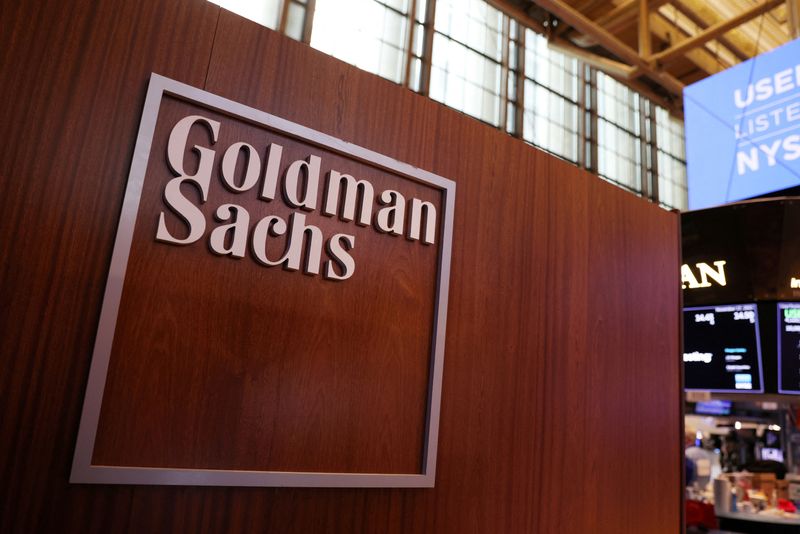By Saeed Azhar and Niket Nishant
NEW YORK (Reuters) -Goldman Sachs' profit more than doubled in the second quarter and beat analysts' estimates on strong debt underwriting and fixed-income trading, but slipped from a bumper first quarter when earnings were the highest since 2021.
The resilience of the U.S. economy has given corporate executives the confidence to pursue acquisitions, debt sales and stock offerings.
"We remain very well-positioned to benefit from a continued resurgence in activity," said Goldman CEO David Solomon, who began a conference call with analysts by condemning the assassination attempt on former U.S. President Donald Trump.
While activity in capital markets and mergers is improving, it remains below historical averages, Solomon said.
Shares climbed as much as 2.3% to a record high, before paring gains to rise 0.3% in late morning trading.
The modest rise is partly because the bank's investment banking gains fell short of those at peers including JPMorgan Chase (NYSE:JPM) and Citigroup, said Stephen Biggar, an analyst at Argus Research.
Earnings rose to $3.04 billion, or $8.62 per share, for the three months ended June 30, about 3% higher than analysts' average expectation of $8.34 per share, according to LSEG.
Goldman is poised for higher earnings from investment banking fees given the significant increase in its backlog, Kenneth Leon, research director at CFRA Research and who has a buy rating on the stock, said in a note.
The results exceeded estimates by narrower margins than in the prior two quarters, when Goldman reported profit that was 35% and 56% higher than estimates.
Goldman's investment banking fees rose 21% to $1.73 billion in the quarter. Fees earned from advising on mergers and acquisitions (M&A) jumped 7%, while debt and stock underwriting climbed 39% and 25%, respectively.
On Friday, JPMorgan reported a 46% jump in investment banking revenue, which jumped 60% at Citigroup.
REFOCUS ON WALL ST
Goldman's profit in the second quarter last year was also hit by writedowns related to GreenSky, a fintech business that Goldman has since sold.
After its foray into consumer banking flopped, Goldman has refocused on its traditional mainstays - investment banking and trading. This year marks the 25-year anniversary of Goldman's initial public offering, the same year Solomon joined the firm.
Investors have supported Goldman's attempt to refocus on its Wall Street operations, pushing the Wall Street titan's stock up 24.4% so far this year. That compares with 11.6% at rival Morgan Stanley (NYSE:MS) and 20.5% at JPMorgan.
Goldman's revenue from fixed income, currency and commodities (FICC) trading rose 17%, boosted by FICC financing, or making loans to private equity investors and other large market participants.
FICC financing revenue climbed 37% to $850 million, just a shade below the record $852 million in the first quarter, driven by mortgages and structured lending.
Goldman has significantly increased short-term loans to private funds as part of a push since 2021.
Equities trading revenue increased 7% including financing activities. The asset and wealth management unit, which manages money on behalf of wealthy and institutional clients, reported revenue in the second quarter rose 27%.
The bank oversees $2.93 trillion of assets. In May, it signed a deal to manage the $43.4 billion pension fund portfolio of parcel delivery giant UPS.
Platform solutions, the unit that houses some of Goldman's consumer operations, reported 2% higher revenue.
The bank's provisions for credit losses were $282 million for the second quarter, compared with $615 million a year earlier.
Goldman's Chief Financial Officer Denis Coleman told analysts the bank plans to "moderate" its stock buybacks. The bank bought back $3.5 billion worth of own stock in the second quarter.
The bank is also in talks with regulators about its recent results in a Federal Reserve's annual health check, Solomon said.
A bank's performance in the so-called "stress test" dictates the size of its stress capital buffer, an extra cushion of capital the Fed requires banks to hold to weather a hypothetical economic downturn. Goldman had one of the biggest increases in stress capital buffers at 94 basis points.
"The year-over-year increase in our stress capital buffer does not seem to reflect the strategic evolution of our business and the continuous progress we've made to reduce our stress loss intensity," Solomon said.
CREDIT CARDS
Goldman Sachs (NYSE:GS) took a $58 million charge on the General Motors (NYSE:GM) credit card business in the second quarter as it prepares to exit the partnership. Goldman had decided to sell the GM card loan portfolio last year.
GM is in talks to replace Goldman with Barclays (LON:BARC), a source familiar with the matter told Reuters in April.
A similar partnership with tech giant Apple (NASDAQ:AAPL) is facing an uncertain future.
Credit cards were an important facet of Goldman's consumer strategy, but it decided to retreat from retail banking after suffering big losses.

In its annual stress test, the Federal Reserve indicated credit cards could be a headache for banks. The potential losses on Goldman's credit card loans were among the worst under the central bank's hypothetical scenario.
Still, Goldman raised its quarterly dividend to $3 per share from $2.75 previously.
